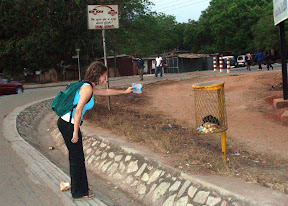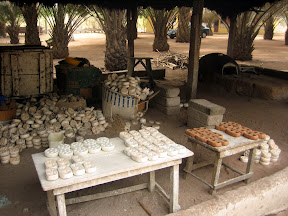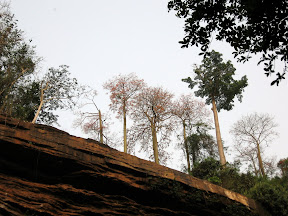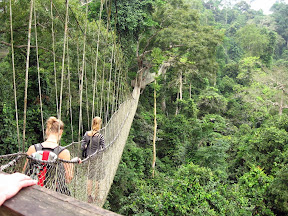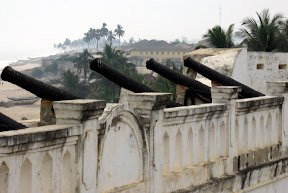Joanne and Josée spent their extra day figuring out the best way to get to Mole National Park. It’s not far from Tamale but the road is bad and so are the vehicles that frequent it. They obviously did a good job because we were at the Mole Motel by 9am without sore bums. We missed the morning hike (it left at 6:30, people start early in Ghana) but were happy to overlook elephants bathing at a watering hole from the hotel patio. In our excitement we almost missed the ones having their lunch right beside some of the hotel rooms. Lucky for us some drivers pointed in the right direction and warned us to keep our distance. My guess is they had experience with Westerns who have only seen large animals in zoos. If I wanted to I could have clambered onto one’s back. I don’t think I’ve had enough practice on mechanical bulls to chance a wild forest elephant. Once the elephants departed for their mid-morning nap, Shannon and I rented some amazingly retro bicycles and set out on the roads south of the park. We were having a gay old time with the absurdity of it all when two elephants meandered across our path. It was quite humbling to be stuck in the middle of Ghana with nothing around but dead trees, burnt grass, and elephants. Needless to say we walked home very slowly.
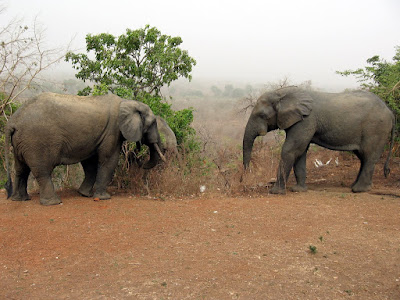
On the evening hike we saw more elephants bathing and showering themselves in dust (homemade sunscreen). Apparently we were lucky to spot a few waterbucks majestically prancing around. The baboons, monkeys, and warthogs are plenty everywhere in the park. Our guide said there are many other animals in the undeveloped part of the park but we don’t want to see anyway because they’ll eat us. I trust him; he had a riffle.
By 4 o’clock the next morning we were crammed into a bus back to Tamale. And by noon we were in Bolgatanga (commonly called Bolga) near the Burkina Faso border. The town was a great spot to soak up Northern culture, travel to a diverse selection of towns, and celebrate Ghana’s 50th Anniversary of Freedom. The northern part of Ghana is very dry, quite understandable given the 40 degree high everyday and complete lack of rain for six months of the year. It’s so hot the sweat doesn’t even have a chance to form on your body before it evaporates. I can see why access to water is such a problem (enter Shannon to save the poor African villagers). The landscape is red/brown, prickly, and littered with donkeys and bikes. I am pretty confident it’s the only place in Africa you’ll find bike lanes (of course, still no sidewalks).
From Bolga we explored a pottery cooperative and some strangers’ houses in Sirigu. The traditional painting is quite unique in its geometric patterns and red, black, and white colours. The houses are skilfully designed for people, animals, and grain. It’s quite amazing what they can do with red clay to create a cool, safe, dry place to live. We went out to the town fairly late in the day since a variety of people told us we could “by all means” get back to Bolga that night. As we were traveling out scepticism set in when we didn’t see a single vehicle traveling in the opposite direction. We took solace in the fact that people are so nice that they’d probably gives us their beds if we were stuck. Luckily we found the last shared taxi going back to Bolga, but it definitely took the scenic route. I was sitting by the window and was completely orange by the time we got to our hotel. I think my lungs still hate me for that.

On Independence Day Shannon and I went to the one Christian town in the north. On the outskirts of town there is a massive tomb, museum, old church, even bigger new church, monastery, and who knows what else devoted to God. Apparently some Canadian missionary named Oscar did his job well. We tried to join the jubilee events but either couldn’t find them or didn’t want to use our white privilege to get to the front. The best part was seeing everyone decked out in red, gold, and green and feeling proud of their country. It reminded me a little of pride; using the time to party for past accomplishments and put off worrying about the future.
